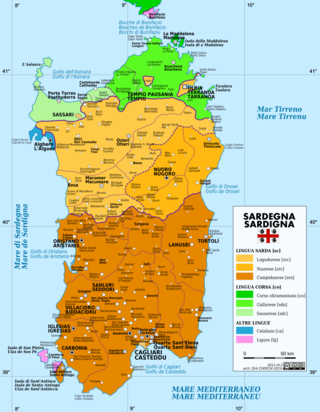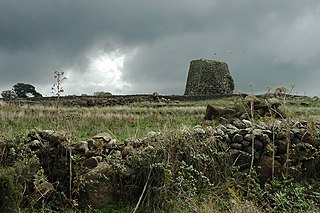
Barbagia is a geographical, cultural and natural region of inner Sardinia, contained for the most part in the province of Nuoro and Ogliastra and located alongside the Gennargentu massif.
Eduardo Blasco Ferrer was a Spanish-Italian linguist and a professor at the University of Cagliari, Sardinia. He is best known as the author of several studies about the Paleo-Sardinian and Sardinian language.

Logudorese Sardinian is one of the two written standards of the Sardinian language, which is often considered one of the most, if not the most conservative of all Romance languages. The orthography is based on the spoken dialects of central northern Sardinia, identified by certain attributes which are not found, or found to a lesser degree, among the Sardinian dialects centered on the other written form, Campidanese. Its ISO 639-3 code is src.

Sardinian or Sard is a Romance language spoken by the Sardinians on the Western Mediterranean island of Sardinia.

Sassarese is an Italo-Dalmatian language and transitional variety between Sardinian and Corsican. It is regarded as a Corso–Sardinian language because of Sassari's historic ties with Tuscany and geographical proximity to Corsica. Despite the robust Sardinian influences, it still keeps its Corsican roots, which closely relate it to Gallurese; the latter is linguistically considered a Corsican dialect despite its geographical location, although this claim is a matter of controversy. It has several similarities to the Italian language, and in particular to the old Italian dialects from Tuscany.
Sardinia is probably the most culturally distinct of all the regions in Italy and, musically, is best known for the tenore polyphonic singing, sacred chants called gosos, the launeddas, an ancient instrument that consists of a set of three single-reed pipes, all three mouth-blown simultaneously using circular breathing, with two chanters and one drone and the cantu a chiterra, a monodic song that is accompanied by guitar, widespread mainly in the center and north of the island.

The Southern Romance languages are a primary branch of the Romance languages.

Giovanni Spano, also a priest and a linguist, is considered one of the first archaeologists to study the Mediterranean island of Sardinia.

The cuisine of Sardinia is the traditional cuisine of the island of Sardinia, and the expression of its culinary art. It is characterised by its own variety, and by the fact of having been enriched through a number of interactions with the other Mediterranean cultures while retaining its own identity. Sardinia's food culture is strictly divided into food from the land and food from the sea, reflecting the island's historical vicissitudes and especially its geographic landscapes, spacing from the coastline to the ragged mountains of the interior. The Sardinian cuisine is considered part of the Mediterranean diet, a nutritional model that was proclaimed by UNESCO as an intangible cultural heritage.

The Sardinians, or Sards, are a Romance language-speaking ethnic group native to Sardinia, from which the western Mediterranean island and autonomous region of Italy derives its name.

Paleo-Sardinian, also known as Proto-Sardinian or Nuragic, is an extinct language, or perhaps set of languages, spoken on the Mediterranean island of Sardinia by the ancient Sardinian population during the Nuragic era. Starting from the Roman conquest with the establishment of a specific province, a process of language shift took place, wherein Latin came slowly to be the only language spoken by the islanders. Paleo-Sardinian is thought to have left traces in the island's onomastics as well as toponyms, which appear to preserve grammatical suffixes, and a number of words in the modern Sardinian language.
Sardo is a hard, grating cow's milk cheese that is similar to Pecorino Romano.

The literature of Sardinia is the literary production of Sardinian authors, as well as the literary production generally referring to Sardinia as an argument, written in various languages.

Sardinian wine is Italian wine produced on the island of Sardinia.
Max Leopold Wagner was a German philologist and ethnologist, particularly known for his studies on the Sardinian language. He also carried out pioneering research on the Spanish language in Hispanic America. In a posthumous review of his three-volume Dizionario etimologico sardo, Ernst Pulgram wrote: It can only be hoped that ... there will arise ... men like Wagner: original thinkers, deep specialists, and great synthesizers of knowledge all at the same time.

Sardinian is conventionally divided, mainly on phonological criteria, into three main varieties: Campidanese, Logudorese, and Nuorese. The last of these has a notably conservative phonology, compared not only to the other two varieties, but also to other Romance languages as well.

S'hymnu sardu nationale, also known by its incipit as Cunservet Deus su Re, was the national anthem of the Kingdom of Sardinia under Savoyard rule and of the Kingdom of Italy.

The Sardinia national football team is the official football team of Sardinia. It is organised by the Sardinian National Sports Federation, founded in 2012. The team has been colloquially referred with the name Sa Natzionale.
Limba Sarda Comuna (LSC) is an orthography for the Sardinian language, created with the aim of transcribing the many variants of spoken Sardinian, with their distinctive characteristics, in the same way, and adopted experimentally in 2006 by the Autonomous Region of Sardinia for the official writing of its acts, jointly with Italian.
The conjugation of Sardinian verbs are mainly divided according to infinitives into -are, -ere, and -ire verbs in north-central dialects for regular verbs, similar to the tripartite systems of Portuguese, Spanish, and Italian. In southern dialects, these infinitives above change to -ai, -i, and -iri, respectively. Irregular verbs also exist as well. Many Sardinian conjugated forms were similar and conservative phonologically to Classical Latin, although the number of tenses were greatly reduced and the remaining tenses rely on periphrasis.













